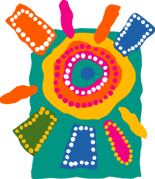
|

For over 40,000 years, prior to European colonisation in 1788, the continent of Australia was inhabited by Indigenous people whose distinctive hunter-gatherer lifestyle centred around the connection between people and land. These Indigenous people used art to exress their identity. With colonisation came radical change but art continued to be a powerful expression of Indigenous identity. The complex relationship between past and present is crucial to contemporary ideas of Aboriginality.
What is Aboriginality?
Prior to European colonisation, the concept of Aboriginality did not exist. Aboriginal people identified as members of a particular clan or cultural language group: e.g. Arrernte, Yolngu or Yorta Yorta and defined themselves through cultural exchange with other communities.
So, how have Aboriginal people developed and maintained ideas of Aboriginality?
Indigenous anthropologist Marcia Langton argues:
| 'Aboriginality' ... is a field of intersubjectivity in that it is remade over and over again in a process of dialogue, of imagination, of representation and interpretation (1993, 33-34). |
For Langton, Aboriginality is created from the dialogue between Aborigines and non-Aborigines.
Anthropologist, Jeremy Beckett, has put forward another definition of Aboriginality:
|
|

Themes
In this module we examine three aspects of Aboriginality:
• Colonial realities
The complex range of Aboriginal historical experiences resulting from European colonization;
• Representations
The stereotypes governing representations of Aboriginality;
• Religion
The religious beliefs that connect Aboriginal people with the land.
|
|
|
| |
Aboriginality, then, is a cultural construction. It shares this quality with all other nationalisms including the Australian being an example of what Ben Anderson has called the 'imagined community'.
[Aboriginality] is a cultural artefact, achieved by remembering things held in common, but also by strategic forgetting. The imagining of communities is not arbitrary, but, like all cultural processes takes place under particular historical and economic circumstances, within a particular cultural tradition and in terms of particular historical experiences. It is these experiences that give the construction its authenticity and also its fluidity.
Beckett, 1988, "Introduction," in Past and Present: The Construction of Aboriginality (ed.) J. Beckett, Aboriginal Studies Press, Canberra, p. 2.) |
|
|
|
| |
|
|
|
| |
View the contents of this module in a table.
|
|
|
| |
|
|
|
| |
Get a list of referenced readings and website urls for this module.
|
|
|
| |
 |
|
|
|
| |
|
|